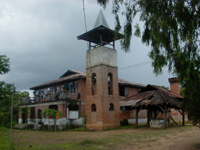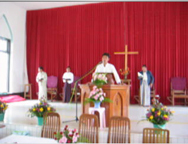Myanmar
In Kengtung, Myanmar, we visited the largest Shan church. It was a very special day for the congregation since it was Adoniram Judson Sunday, a yearly celebration of the accomplishments of Myanmar’s first American missionary. Many aspects were not altogether different than many traditional services in the West. However, the men and women sat on separate sides of the church and the service was spoken in Shan. The congregation is quite large in size and lives within the same village of about 400 houses.
 |
When asked about the obstacles for the church; several were mentioned. One prevalent problem was unemployment. Many members of the congregation had difficulty obtaining and keeping jobs because they are Christians. As a result, some have turned to alcohol. Another hurdle for the church, as expressed by an associate pastor, was that many church attendees believe they were born Christians since their parents, grandparents, and so on, were Christians.
We also visited a Shan Bible school, the only such school with a specific focus on the Shan. While there are other Bible schools in the Shan state, they teach in English and Burmese and do not cater to the specific needs of the Shan. In existence since 1997, the administration is looking to complete the construction of a library, as well as an academic building. Currently, many of the classes are held in the administrative building.
 |
 |
The student body currently consists of 15 students–2 female, 13 male–with a faculty of 10 teachers. A school year consists of 6 months of academic studies and 6 months serving at home churches or other ministries. Students and teachers alike showed great enthusiasm for church planting and evangelism. Already, as a result of teaching received through this school, six churches have been planted throughout the Shan state.
In Hsipaw, there is currently no Shan church. While there are a number of both Burmese and Lisu churches, there are only a few scattered Shan believers that attend them. The head deacon at one of the major churches in town, gave us some great insight into the work and challenges of the church in Hsipaw..
A big problem in the church in Hsipaw is that many of the Christians are in prison because they have been caught either taking drugs or selling them. The drugs are mostly heroin and methamphetamines and about 5% of the population in Hsipaw have drug related problems. It’s rampant amongst both women and men. Some of them had habits before they became Christians, and some have developed habits in disobedience. In an effort to address this problem the church in Lashio has set up a program where they try to help Christians get off of heroin and teach them a trade. They struggle to gather enough good materials, though, and they have very little supplementary teaching material apart from the Bible.
The church in Hsipaw suffers from mild persecution. Sometimes, the church has undergone vandalism. When the church has gone to the government to get repairs, the government will not give permission to get the repairs done. The government also puts limits on church growth. They do not want the church to be growing.
The main problem is that the pastor is limited in his ability to preach the gospel. Although no pastors have been jailed for preaching, they often have to undergo a lot of questions. Some feel “The government supports the Muslim religion and encourages them to suppress the Christians. We have a fear of evangelism because we feel that the government will clamp down on us. So we have to pray a lot and go out in faith”. There is a fear of the unknown. Christians are not sure of what will happen to them.
It seems that the church in Hsipaw does have an understanding of the need for outreach, but this is not necessarily focused on the Shan people.



